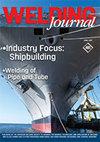Melting Characteristics of C-Type Filler Metal in GTAW
IF 1.4
3区 材料科学
Q2 METALLURGY & METALLURGICAL ENGINEERING
引用次数: 1
Abstract
A C-type filler metal was developed to overcome the low deposition rate (DR) of gas tungsten arc welding (GTAW). The present study investigated the maximum DR for a novel C-type filler metal and compared it to conventional circular welding wires during GTAW using an Alloy 625 filler metal. For comparison with conventional circular welding wires, a ø1.2-mm (0.047-in.) welding wire, which is most widely used in practice, and a ø2.4-mm (0.094-in.) welding wire, which has almost the same sectional area as the novel C-type filler metal, were used in this research. An industrial robot was utilized to produce bead-on-plate welds in the flat position. The results revealed that at the same 200-A welding current, the DR of the C-type filler metal was higher than the conventional circular welding wires by 1.17 to 1.4 times according to the sectional area of the circular welding wires. At a high welding current of 500 A, it was impossible for the ø1.2-mm welding wire to deposit quality welds, and the acceptable range of the DR for the ø2.4-mm welding wire was narrow (i.e., 7–8 kg/h [15.4–17.6 lb/h]). However, the acceptable range of the DR for the C-type filler metal was as broad as 5.04–12.1 kg/h (11.1–26.6 lb/h) under the high welding current of 500 A. The maximum DR of the C-type filler metal was 1.51 times that of the ø2.4-mm welding wire. The mechanism of obtaining a high DR using the C-type filler metal was analyzed from the viewpoint of the continuous bridging transfer at the melting edge of the C-type filler metal. The ability of the C-type filler metal to achieve high DRs at high-current regions was superior to the conventional ø1.2- and ø2.4-mm welding wires.c型钎料在GTAW中的熔化特性
针对钨极气体保护焊(GTAW)中沉积速率低的问题,研制了一种c型填充金属。本文研究了一种新型c型填充金属在GTAW中的最大DR,并将其与使用Alloy 625填充金属的传统圆形焊丝进行了比较。为了与传统的圆形焊丝进行比较,本研究采用了在实践中使用最广泛的ø1.2 mm (0.047-in.)焊丝和与新型c型填充金属具有几乎相同截面积的ø2.4 mm (0.094-in.)焊丝。利用工业机器人在平面位置进行了焊头焊接。结果表明,在相同的200a焊接电流下,按圆形焊丝的截面积计算,c型钎料的DR比常规圆形焊丝高1.17 ~ 1.4倍。在500a的高焊接电流下,ø1.2 mm焊丝不可能焊出高质量的焊缝,而ø2.4 mm焊丝的DR可接受范围较窄(即7-8 kg/h [15.4-17.6 lb/h])。然而,在500a的高焊接电流下,c型填充金属的可接受DR范围为5.04-12.1 kg/h (11.1-26.6 lb/h)。c型钎料的最大DR为ø2.4 mm焊丝的1.51倍。从c型钎料熔点边缘连续桥接转移的角度分析了c型钎料获得高DR的机理。c型填充金属在大电流区域获得高dr的能力优于传统的ø1.2和ø2.4 mm焊丝。
本文章由计算机程序翻译,如有差异,请以英文原文为准。
求助全文
约1分钟内获得全文
求助全文
来源期刊

Welding Journal
工程技术-冶金工程
CiteScore
3.00
自引率
0.00%
发文量
23
审稿时长
3 months
期刊介绍:
The Welding Journal has been published continually since 1922 — an unmatched link to all issues and advancements concerning metal fabrication and construction.
Each month the Welding Journal delivers news of the welding and metal fabricating industry. Stay informed on the latest products, trends, technology and events via in-depth articles, full-color photos and illustrations, and timely, cost-saving advice. Also featured are articles and supplements on related activities, such as testing and inspection, maintenance and repair, design, training, personal safety, and brazing and soldering.
 求助内容:
求助内容: 应助结果提醒方式:
应助结果提醒方式:


